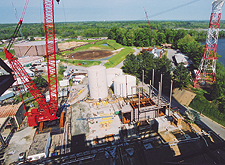On the heels of a record clean air settlement announced late last month with Dominion Virginia Power, the Bush administration said April 29 that it had reached a similar agreement with Wisconsin Electric Power Co.
Under the settlement announced by the Justice Dept. and the U.S. Environmental Protection Agency, Milwaukee-based WEPCO will spend $600 million to install new pollution controls at four coal-fired powerplants in Wisconsin and one in Michigan. Together, they consist of 23 electricity-generating units. To achieve the emission goals, the firm also could choose to shut down older units.
 |
| CLEANING UP Dominion's Chesterfield plant installed selective catalytic reduction. (Photo courtesy of Dominion) |
The changes are expected to reduce annual emissions of sulfur dioxide by 72,300 tons and nitrogen oxide by 32,600 tons. WEPCO also will improve its control of particulate matter and spend at least $20 million to finance an environmental mitigation project demonstrating a new technology to significantly reduce mercury emissions. This action resolves the government's claims that WEPCO violated the New Source Review provisions of the federal Clean Air Act at several of its facilities by making major modifications that increased air pollution without installing required pollution controls.
Construction is under way or nearly completed at eight of the coal-fired powerplants operated by Richmond-based Dominion. On April 21, the government said Dominion would spend $1.2 billion by 2013 to eliminate 237,000 tons annually of sulfur dioxide and nitrogen oxide emissions at six facilities in Virginia and two in West Virginia. The eight plants comprise 20 electricity-generating units that emitted over 350,000 tons of SO2 and Nox in 2000. These emissions are expected to be reduced by about 67% by 2013. The settlement is the largest enforcement case against a utility under the New Source Review program.
Dominion went with proven technologyflue-gas desulfurization using limestone as the agentwhen installing scrubbers to reduce SO2 at its Mt. Storm facility, says David Craymer, Dominion's director of operations services. But engineers lined the absorber vessels with a special ceramic tile instead of the traditional alloy steel lining. "We've been pleased," Craymer says, noting that he is not aware of any other large absorber vessel where the tiles have been used.
David G. Hawkins, director of the Natural Resources Defense Council's climate center, says it is ironic that these settlements were reached as the Bush administration is trying to change the New Source Review provisions that allowed the enforcement actions to go forward. If EPA's proposed changes to the NSR program are made, "the very things these companies were charged with doing, those very activities of rebuilding those plants piece-by-piece would become lawful," he says.


Post a comment to this article
Report Abusive Comment